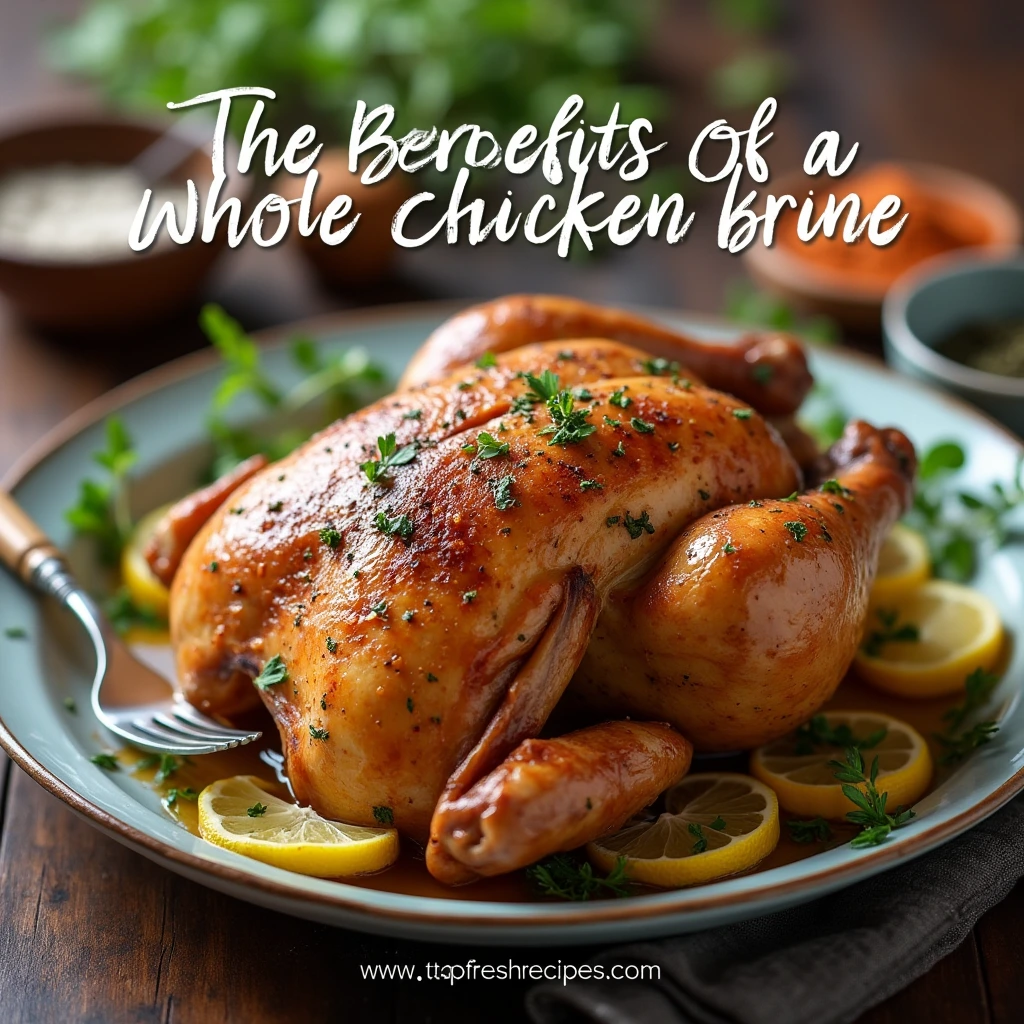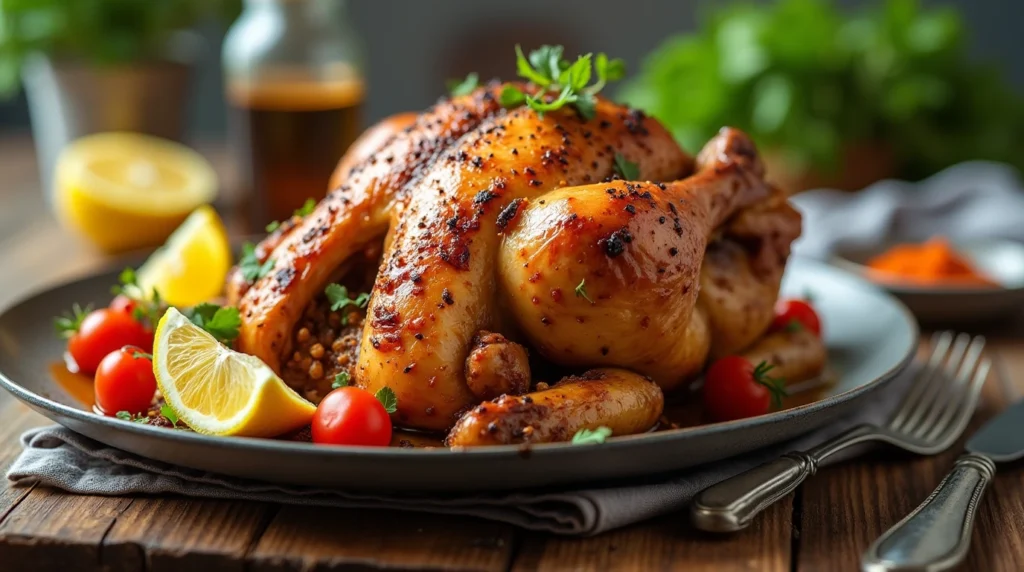Table of Contents
Benefits of a Whole Chicken Brine: The Culinary Conundrum of Dry Chicken
Imagine this scenario: You’ve spent hours carefully preparing a chicken dinner, meticulously following a recipe, only to slice into the meat and find it’s dry, tough, and about as appetizing as sawdust. It’s a culinary nightmare that has plagued home cooks and professional chefs alike – the dreaded dry chicken syndrome.
But what if there was a foolproof method to guarantee juicy, flavorful chicken every single time? Enter brining – the secret weapon that transforms ordinary chicken into a mouth-watering masterpiece. This isn’t just another cooking technique; it’s a game-changing approach that will revolutionize the way you prepare chicken.
In this comprehensive guide, we’ll embark on a deep dive into the world of brining. From the scientific principles behind this magical process to step-by-step recipes that will make you the star of any dinner table, we’ll cover everything you need to know about turning dry, bland chicken into a culinary triumph.
The Chicken Dilemma: Why Moisture Matters
Let’s address the elephant in the room – why is chicken so notoriously difficult to cook perfectly? The answer lies in the unique composition of chicken meat. Unlike beef or pork, chicken has less fat and more lean muscle, making it prone to drying out during cooking. This is where brining becomes your secret weapon.
The Moisture Challenge
- Chicken breast contains approximately 73% water
- Cooking can cause protein fibers to contract, squeezing out moisture
- Traditional cooking methods often result in up to 30% moisture loss
Why Brine? The Transformative Benefits of a Whole Chicken Brine
Brining might seem like an extra step in your cooking process, but the benefits are nothing short of miraculous:
- Moisture Retention
- Increases meat’s water-holding capacity
- Reduces moisture loss during cooking by up to 40%
- Ensures every bite remains succulent and tender
- Flavor Enhancement
- Allows seasonings to penetrate deep into the meat
- Creates a more complex, layered taste profile
- Transforms bland chicken into a flavor explosion
- Consistent Cooking
- Helps chicken cook more evenly
- Reduces the risk of dry edges and undercooked centers
- Provides a forgiving cooking process for less experienced cooks
Brining Applications: Beyond the Whole Chicken
While whole chickens are the most common candidate for brining, this technique works wonders for various cuts:
Versatile Brining Options
- Whole Chickens: Perfect for roasting and special occasions
- Boneless Chicken Breasts: Ideal for quick weeknight meals
- Chicken Wings: Game-day appetizers that stay juicy
- Chicken Drumsticks: Great for grilling and barbecues
- Chicken Thighs: Works beautifully for both bone-in and boneless cuts
The Science of Brining: A Molecular Culinary Adventure
Brining is more than just a cooking technique – it’s a fascinating interplay of chemistry and culinary art. Salt is the true hero of this process, working its magic on protein molecules in ways that seem almost miraculous.
How Salt Works Its Magic
- Protein Denaturation: Salt breaks down protein structures
- Moisture Chambers: Creates tiny water-holding pockets within muscle fibers
- Flavor Penetration: Helps seasonings move deeper into the meat
The Osmosis Effect
When you introduce a saltwater solution to chicken, an incredible process begins. The salt causes the meat’s proteins to unwind, creating spaces that can hold more moisture. Think of it like expanding a sponge’s capacity to absorb water.
Wet vs. Dry Brining: Choosing Your Method
Not all brines are created equal. You have two primary approaches, each with unique advantages:
Wet Brining: The Traditional Method
Characteristics:
- Longer preparation time (12-24 hours)
- Maximum moisture retention
- Easy flavor infusion
- Requires more refrigerator space
Pros:
- Deeply hydrates the meat
- Allows for complex flavor additions
- Ideal for larger cuts and whole chickens
Cons:
- Can dilute natural chicken flavor
- Requires more cleanup
- Less crispy skin
Dry Brining: The Modern Approach
Characteristics:
- Quicker process (12-24 hours)
- Concentrates natural flavors
- Minimal preparation required
- Promotes crispy skin
Pros:
- Easier storage
- More intense flavor
- Crisp exterior
- Less messy
Cons:
- Slightly less moisture retention
- Requires precise salt measurement


Essential Brining Ingredients: Crafting Flavor Profiles
While salt remains the fundamental ingredient, the right additions can transform a basic brine into a culinary masterpiece.
Wet Brine Flavor Enhancers
- Herbs: Rosemary, thyme, sage
- Aromatics: Garlic, shallots, ginger
- Spices: Black peppercorns, bay leaves
- Citrus: Lemon zest, orange peel
- Sweet Elements: Brown sugar, honey
Dry Brine Seasoning Blends
- Classic Mix: Kosher salt, dried herbs
- Spicy Blend: Smoked paprika, cayenne
- Mediterranean Style: Oregano, lemon zest
- Herb-Focused: Dried parsley, thyme, rosemary
Detailed Brining Recipes: Your Path to Chicken Perfection
Comprehensive Wet Brine Recipe
Ingredients:
- 1 gallon water
- 1 cup kosher salt
- 1/2 cup brown sugar
- 4 bay leaves
- 6 garlic cloves
- 2 sprigs fresh rosemary
- 1 lemon, sliced
- 1 tablespoon black peppercorns
Step-by-Step Instructions:
- Combine water, salt, and sugar in a large pot
- Heat until salt and sugar dissolve completely
- Add aromatics and herbs
- Cool brine to refrigerator temperature
- Submerge chicken entirely
- Refrigerate 12-24 hours
- Rinse and pat dry before cooking
Foolproof Dry Brine Method
Ingredients:
- 2 tablespoons kosher salt
- 1 teaspoon baking powder
- 1 tablespoon dried herbs
- 1 teaspoon garlic powder
Technique:
- Mix dry ingredients thoroughly
- Ensure chicken is patted completely dry
- Generously coat entire chicken surface
- Place on a rack in the refrigerator
- Let sit 12-24 hours
- No rinsing required – just cook as desired
Roasting Brined Chicken: Techniques for Success
Essential Roasting Tips
- Always use a meat thermometer
- Let chicken rest 10-15 minutes after cooking
- Aim for internal temperature of 165°F
- Use a rack to promote even air circulation
Two Gourmet Roast Chicken Recipes
Garlic Butter Roast Chicken
Ingredients:
- 1 whole brined chicken
- 1/2 cup unsalted butter
- 8 garlic cloves, minced
- Fresh thyme and rosemary
- Lemon
- Salt and freshly ground pepper
Detailed Instructions: (Previously provided instructions remain the same)
Moroccan-Inspired Roasted Chicken
Ingredients:
- 1 whole brined chicken
- Ras el hanout spice blend
- Dried apricots and preserved lemon
- Olive oil
- Cinnamon stick
- Fresh cilantro
Comprehensive Preparation: (Previously provided instructions remain the same)
Conclusion: Your Culinary Transformation Begins Now
Brining is more than a cooking technique – it’s a culinary revolution. By understanding the science, mastering the methods, and embracing creativity, you’ll transform every chicken dish from mundane to magnificent.
Remember: Great cooking is part science, part art, and entirely about passion. Brining gives you the tools to express your culinary creativity and delight everyone at your table.
Tell us how did you find this recipe?
There are no reviews yet. Be the first one to write one.


1 thought on “The Best Benefits of a Whole Chicken Brine Using 2 Methods”
Comments are closed.